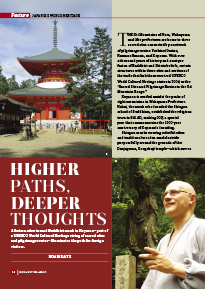Home > Highlighting JAPAN >Highlighting Japan September 2015>Japanese World Heritage
Highlighting JAPAN

Japanese World Heritage
Higher Paths, Deeper Thoughts
A Swiss native turned Buddhist monk in Koyasan—part of a UNESCO World Cultural Heritage string of sacred sites and pilgrimage routes—illuminates the path for foreign visitors.

The Kii Mountains of Nara, Wakayama and Mie prefectures are home to three sacred sites connected by a network of pilgrimage routes: Yoshino/Omine, Kumano Sanzan, and Koyasan. With over a thousand years of history and a unique fusion of Buddhist and Shinto beliefs, certain structures within these sites and sections of the trails that link them received UNESCO World Cultural Heritage status in 2004 as the “Sacred Sites and Pilgrimage Routes in the Kii Mountain Range.”
Koyasan is nestled amidst the peaks of eight mountains in Wakayama Prefecture. Kukai, the monk who founded the Shingon school of Buddhism, established the religious town in 816 AD, making 2015 a special year that commemorates the 1200-year anniversary of Koyasan’s founding.
Shingon monks wearing colorful robes and traditional wooden sandals stride purposefully around the grounds of the Danjogaran, Kongobuji temple—which serves as the Shingon School’s headquarters—as well as on the forested path to the Okunoin, where Kukai now rests. One monk, with a distinctly Caucasian face, can be seen around town chatting with locals and Japanese and foreign tourists alike in German, French, English and Italian as well as Japanese. This polyglot is Kurt Kubli Genso, a Swiss native who came to Koyasan eighteen years ago and became a Buddhist priest.
In addition to pursuing his own religious studies and providing assistance to charities, Genso spends a lot of time helping Westerners visiting Koyasan, explaining historical sites. He also gives talks about Koyasan both in Japan and abroad. In 2008, the Ministry of Land, Infrastructure, Transport and Tourism appointed Genso a Yokoso Japan Ambassador for his contributions, an accolade that he jokingly refers to as being “a PR monk.”
Unlike World Heritage Sites that show visitors of times past, Genso describes the parts of Koyasan recognized by UNESCO as “living” cultural assets.
“Koyasan is not simply a monument,” he says, explaining that while its roots are ancient, fires have ravaged many of its temples over the past twelve centuries. Those that survive are reconstructions. (Indeed, only around a hundred temples remain in the town compared to the over 1,865 that existed in 1644.) Genso compares Koyasan to “a stage where things are constantly happening.” Early morning rituals are observed daily throughout the temples, while traditional events are conducted regularly throughout the year at Kongobuji, Danjogaran and Okunoin.
“In Koyasan, there is harmony between architecture and nature,” Genso states, gesturing toward wooden temples with moss-covered roofs as birds and higurashi cicadas serenade from above in the branches of towering green cryptomeria trees. The rich visual landscape of nature and historical structures complements an aural landscape in which the sounds of monks chanting are punctuated by the deep tolling of temple bells at certain hours.
The temple where Genso lives, Muryokoin, is one of approximately fifty temples in the area that offer shukubo lodging. Here visitors can stay overnight in the temple, eat shojin ryori—the traditional vegetarian cuisine of Buddhist monks—and participate in morning religious services. Genso believes that this chance to immerse oneself in Japanese culture and experience the spirituality of Koyasan is part of its increasing popularity among foreign tourists. In 2004, Koyasan was receiving about four thousand foreign visitors per year. Genso estimates it attracts ten times that number now.
“This is one of a few spiritual places in the world,” Genso declares. “The heart is changed. People come as tourists, but leave as pilgrims.” He is confident that both Japanese and foreigners alike can experience something unique in Koyasan.
© 2009 Cabinet Office, Government of Japan






